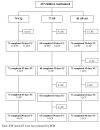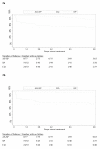Extended high efficacy of the combination sulphadoxine-pyrimethamine with artesunate in children with uncomplicated falciparum malaria on the Benin coast, West Africa
- PMID: 19257898
- PMCID: PMC2653068
- DOI: 10.1186/1475-2875-8-37
Extended high efficacy of the combination sulphadoxine-pyrimethamine with artesunate in children with uncomplicated falciparum malaria on the Benin coast, West Africa
Abstract
Background: A study carried out in 2003-2005 in Southern Benin showed a day-28 sulphadoxine-pyrimethamine (SP) monotherapy failure rate greater than 40%, while for SP combined with artesunate (SP-AS) the failure rate was 5.3%. Such a large difference could be explained by the relatively short 28-day follow-up period, with a substantial number of recurrent infections possibly occurring after day 28. This paper reports the treatment outcome observed in the same study cohort beyond the initial 28-day follow-up.
Methods: After the 28-day follow-up, children treated with either chloroquine alone (CQ), SP or SP-AS, were visited at home twice a week until day 90 after treatment. A blood sample was collected if the child had fever (axillary temperature > or =37.5 degrees C). Total clinical failure for each treatment group was estimated by combining all the early treatment failures and late clinical failures that occurred over the whole follow-up period, i.e. from day 0 up to day 90. Pre-treatment randomly selected blood samples were genotyped for the dhfr gene (59) and the dhps gene (437 and 540) point mutations related to SP resistance.
Results: The PCR-corrected clinical failure at day 90 was significantly lower in the SP-AS group (SP-AS: 2.7%, SP alone: 38.2%; CQ: 41.1%) (Log-Rank p < 0,001). The most prevalent haplotype was dhfr Arg-59 with the dhps Gly-437 mutant and the dhps 540 wild type (85.5%). The dhps 540 mutation could be found in only three (8.3%) samples.
Conclusion: Combining artesunate to SP dramatically increased the treatment efficacy, even when extending the follow-up to day 90 post-treatment, and despite the high percentage of failures following treatment with SP alone. Such a good performance may be explained by the low prevalence of the dhps 540 mutation, by the rapid parasite clearance with artesunate and by the level of acquired immunity.
Figures


Similar articles
-
Adding artesunate to sulphadoxine-pyrimethamine greatly improves the treatment efficacy in children with uncomplicated falciparum malaria on the coast of Benin, West Africa.Malar J. 2007 Dec 21;6:170. doi: 10.1186/1475-2875-6-170. Malar J. 2007. PMID: 18154655 Free PMC article. Clinical Trial.
-
Efficacy of sulphadoxine-pyrimethamine with or without artesunate for the treatment of uncomplicated Plasmodium falciparum malaria in southern Mozambique: a randomized controlled trial.Malar J. 2009 Jun 26;8:141. doi: 10.1186/1475-2875-8-141. Malar J. 2009. PMID: 19558654 Free PMC article. Clinical Trial.
-
A clinical and molecular study of artesunate + sulphadoxine-pyrimethamine in three districts of central and eastern India.Malar J. 2013 Jul 17;12:247. doi: 10.1186/1475-2875-12-247. Malar J. 2013. PMID: 23866298 Free PMC article. Clinical Trial.
-
Artemisinin derivatives for treatment of uncomplicated Plasmodium falciparum malaria in Sudan: too early for too much hope.Parasitol Res. 2010 Feb;106(3):549-52. doi: 10.1007/s00436-009-1700-x. Epub 2009 Dec 15. Parasitol Res. 2010. PMID: 20012990 Review.
-
The efficacy and safety of intermittent preventive treatment with sulphadoxine-pyrimethamine vs artemisinin-based drugs for malaria: a systematic review and meta-analysis.Trans R Soc Trop Med Hyg. 2022 Apr 4;116(4):298-309. doi: 10.1093/trstmh/trab158. Trans R Soc Trop Med Hyg. 2022. PMID: 34651193
Cited by
-
Protective efficacy of co-trimoxazole prophylaxis against malaria in HIV exposed children in rural Uganda: a randomised clinical trial.BMJ. 2011 Mar 31;342:d1617. doi: 10.1136/bmj.d1617. BMJ. 2011. PMID: 21454456 Free PMC article. Clinical Trial.
-
High rates of parasite recrudescence following intermittent preventive treatment with sulphadoxine-pyrimethamine during pregnancy in Benin.Malar J. 2013 Jun 10;12:195. doi: 10.1186/1475-2875-12-195. Malar J. 2013. PMID: 23758883 Free PMC article.
-
Low prevalence of highly sulfadoxine-resistant dihydropteroate synthase alleles in Plasmodium falciparum isolates in Benin.Malar J. 2021 Feb 5;20(1):72. doi: 10.1186/s12936-021-03605-5. Malar J. 2021. PMID: 33546703 Free PMC article.
-
The impact of home-based management of malaria on clinical outcomes in sub-Saharan African populations: a systematic review and meta-analysis.Trop Med Health. 2024 Jan 8;52(1):7. doi: 10.1186/s41182-023-00572-2. Trop Med Health. 2024. PMID: 38191459 Free PMC article.
-
The economic impact of substandard and falsified antimalarial medications in Nigeria.PLoS One. 2019 Aug 15;14(8):e0217910. doi: 10.1371/journal.pone.0217910. eCollection 2019. PLoS One. 2019. PMID: 31415560 Free PMC article.
References
-
- Ministère de la Santé . Atelier de consensus sur le changement de la politique de traitement antipaludique Programme National de Lutte contre le Paludisme. Cotonou: DNPS; 2004. pp. 1–10.
-
- Ministère de la Santé . Politique Nationale de Lutte contre le Paludisme et cadre stratégique de mise en œuvre Programme National de Lutte contre le Paludisme. Cotonou. DNPS; 2005. pp. 1–50.
-
- Ministère de la Santé . Programme National de Lutte contre le Paludisme. Cotonou. DNPS; 1992.
-
- Kyabayinze D, Cattamanchi A, Kamya MR, Rosenthal PJ, Dorsey G. Validation of a simplified method for using molecular markers to predict sulfadoxine-pyrimethamine treatment failure in African children with falciparum malaria. Am J Trop Med Hyg. 2003;69:247–52. - PubMed
-
- Kublin JG, Dzinjalamala FK, Kamwendo DD, Malkin EM, Cortese JF, Martino LM, Mukadam RA, Rogerson SJ, Lescano AG, Molyneux ME, Winstanley PA, Chimpeni P, Taylor TE, Plowe CV. Molecular markers for failure of sulfadoxine-pyrimethamine and chlorproguanil-dapsone treatment of Plasmodium falciparum malaria. J Infect Dis. 2002;185:380–388. doi: 10.1086/338566. - DOI - PubMed
Publication types
MeSH terms
Substances
LinkOut - more resources
Full Text Sources
Research Materials

